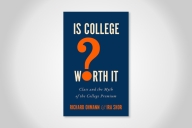You have /5 articles left.
Sign up for a free account or log in.
Questions of co-authorship can be contentious. How much work does one have to do to be considered a co-author? Should names be listed alphabetically or based on the level of contribution? How many co-authors are too many?
Phil Davis stands out because he didn’t ask himself, or anyone else, any of these questions. When he published his recent paper in The Journal of Chemical Thermodynamics, he listed John Kilpatrick as a co-author without a second thought – even though Kilpatrick died 17 years ago.
“I never even thought about not including him,” said Davis, an industrial research professor in the University of North Florida’s chemistry department.
Kilpatrick was Davis’s Ph.D. adviser at Rice University, where Davis earned his doctorate in 1968. The recent paper draws on research Davis did under Kilpatrick’s supervision.
“Even though he didn’t make any of the measurements or any of the interpretations associated with it, there was a thread of his input in everything I did,” Davis said.
Davis credits Kilpatrick not only with helping to guide his research, but also with teaching him skills that became invaluable to his career. Davis described Kilpatrick as a researcher who was equally skilled in experimentation and theory, and who believed his students should be comfortable with both areas, too. Kilpatrick taught his students practical experimental techniques, but would also challenge the group with thought-games, and watch them struggle toward the answer.
“The main thing he taught me was not so much the specifics of this particular molecule, but how to problem-solve in a general sense,” Davis said.
He recalls using Kilpatrick’s lessons while working in the chemical industry. Rarely, he said, did the specific equations or formulas matter, but the ability to think logically did.
“The end goal was to solve the problem, not to find out who got the credit for it,” he said.
Davis’ decision to list Kilpatrick as a co-author came as a pleasant surprise to Terry Kilpatrick, John’s daughter. Terry, the member services director at Temple University’s Association of University Professionals, the faculty union, said she is proud to see her father recognized and appreciated. “I work at a university, I hear so much nastiness going on and people hurt and not treated well, that for Phil to remember my father this way after all these years is so nice,” she said.
Terry believes her father would have been “shy, but very, very pleased” with Davis’s choice to split credit. She said her father cared deeply about his students and enjoyed seeing them succeed.
“If you were interested in the work and wanted to learn it, he wanted to teach it so much that he would take endless amounts of time with you,” she said.
That was true of Davis’ experience working with John Kilpatrick, and it was why he felt credit for the paper needed to be shared.
“He was greatly interested personally in his graduate students, and wanted to make sure that they had all the resources we needed after we completed our degree to be successful in whatever career we pursued,” Davis said. “All through the years I have felt his influence and attachment to the type of research I was going, and I felt that it was the right and proper thing to do, to include him on the paper.”








